How to Find Fossils
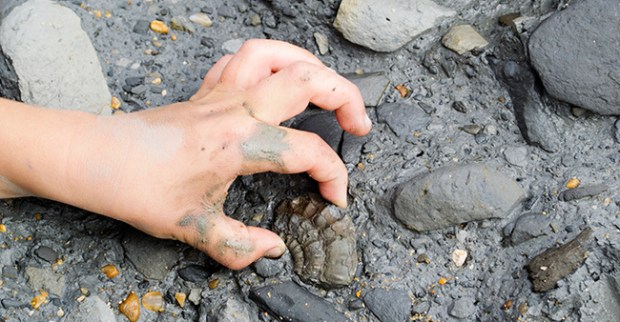
Sometimes a rock’s just a rock … and sometimes it’s a fossil. How can you tell the difference?
Research which fossils are common where you’ll be hiking
Stop by a museum or visitor center, call a local university’s geology department or search for a club of paleontologists (people who study fossils of plants and animals).
Find the right kind of rocks
Fossils are found in sedimentary rocks, like sandstone, limestone or shale. Sedimentary rocks look like layered pancakes.
Look for exposed rock
Check out stream cuts, bluffs, sea cliffs, road cuts or any place where bedrock is eroding.
Get low
You’ll see more fossils when you’re on your hands and knees. Use a magnifying lens. Form a “search image” in your mind. If you spotted ammonites at a nearby rock shop, think about what they looked like. Search for spirals and snail shapes. And remember that most fossils are small sea animals – not rare dinosaur bones.
Don’t take fossils
Leave fossils as you found them, so others can enjoy them, unless directed otherwise by local authorities. If you think you’ve found something unusual, make a careful note of its exact location — information that’s as important as the rock itself. A fossil’s location tells its story, where and how the animal lived.
FIVE EASY-TO-FIND FOSSILS
Here are five fossils that you can look for on your next hike.
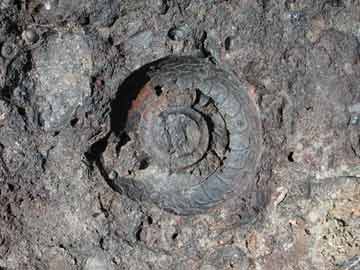 Ammonoids
Ammonoids
People in the Middle Ages called ammonoids “snake stones” because they thought the fossils were coiled snakes.
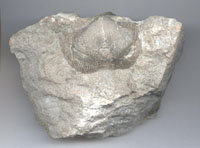 Brachiopods
Brachiopods
Scientists say most brachiopods disappeared 250 million years ago, when as much as 95 percent of ocean animals died in a mass extinction.
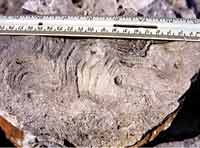 Corals
Corals
Algae lives inside the coral, giving it nutrients and oxygen.
Crinoids
This flower-shaped animal’s anus was next to its mouth.
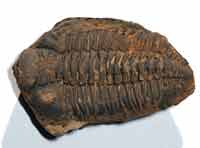 Trilobites
Trilobites
Growing trilobites crawled out of old exoskeletons through head splits, giving their fossils “facial structures.”
Finding fossils depends on many factors. First, you need to know where to luck. River banks are a good place to start. You are looking for brown rocks called conretions. They look like thick muddish colored flattened rocks. You will have to crack them with a rock hammer. Wear safety glasses always. If you put the rock on its side and smack it with a hammer, it will open easily and often there are very cool fern, plants, insects, etc. Sometimes, in existing rocks, you will find fossils—you must look very closely. Sometimes the entire rock is a fossil. Sometimes there are parts of the rock that has fossils. Look for bivalves, brachipods, clams, corals. It really depends on where you live. Plug in the words fossils on the Internt and click images. This will give you an idea of what you are looking for. Go to your state museum’s website and look for their geology department. I have visited several geologists and seen their personal collection by merely asking them questions. Research your area. Find out if the rocks in your area are of the Silurian time perios or Pennsylvanian era, etc. The websites will tell you what kind of fossils are probably in your area. Go online and see if there are rock clubs you can join in your area. They are very family oriented. They take fieldtrips to fossil-rich areas. You have to do your homework before you begin. It is a fascinating hobby. Good luck!
the great plians used to be underwater, so you can find fossils of ocean animals there.
i find tons of fossils!!!!!!!!
lol…….its kinda cool…. trilobites, ammonites, shark teeth……..
i was down by the creek and there were rocks with circles. what kind do you soppose they are
what are the kinds of fossils name that has circles?
I think that is so cool i love fossils but dont have or know how to find them!!!
I live on a farm in Maryland and on my farm there is lots of rocky areas. A couple years ago I was walking on my farm and near a rocky spot in the ground I saw a brown rock that had a row of different shades of purple. I thought the rock locked cool so i cept it. A year later in my den we were studying fosils and my den leader said that we could probably find fosils at our house. Then I thought of the rock i found. The next day i brought the rock to my den and it turns out that the rock was a fosil.
i love fossil’s. tere cool!! LOVE! FOSSILS!!!!
I LOVE FOSSILS BUT I DO NOT KNOW HOW TO FIND THEM!!!!!!!!!!!
yaaay!